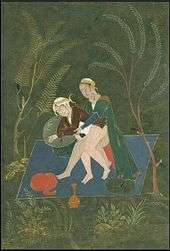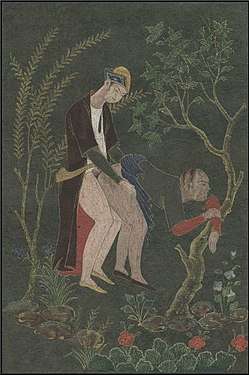LGBT history in Iran
This article covers the LGBT history of Iran.
Pre-Islamic period
Ancient Iranian society had a tradition of polytheism and initiatory pederasty, which came into sharp conflict during the Achaemenid period. Iranian pederasty and its origins was debated even in ancient times - for example, Herodotus claimed they had learned it from the Greeks: "From the Greeks they have learned to lie with boys."[1] However, Plutarch asserts that the Iranians used eunuch boys to that end long before contact between the cultures. [2] In either case, Plato claimed they saw fit to forbid it to the inhabitants of the lands they occupied, since "It does not suit the rulers that their subjects should think noble thoughts, nor that they should form the strong friendships and attachments which these activities, and in particular love, tend to produce."[3]
Sextus Empiricus writing in his "Outlines of Scepticism" (circe C.E 200) asserted that the laws of the Persians were tolerant of homosexual behaviour, and the men "indulge in intercourse with males" (1:152)[4]
Around 250 BCE, during the Parthian Empire, the Zoroastrian text, the Vendidad, was written. It contains provisions that are part of sexual code promoting procreative sexuality that is interpreted to prohibit same-sex intercourse as a form of demon worship, and thus sinful. Ancient commentary on this passage suggests that those engaging in sodomy could be killed without permission from the Dastur. However, a strong homosexual tradition in Iran is attested to by Greek historians from the 5th century onward, and so the prohibition apparently had little effect on Iranian attitudes or sexual behavior outside the ranks of devout Zoroastrians in rural eastern Iran.[5][6][7][8][9][10]
Islamic period


There is a significant amount of literature in Persian that explicitly illustrates the ancient existence of homosexuality among Iranians.[11] In Persian poetry, references to sexual love can be found in addition to those of spiritual/religious love. A few ghazals (love poems) and texts in Saadi's Bustan and Gulistan have been interpreted by Western readers as homoerotic poems. In some poems, Sa'di's beloved is a young man, not a beautiful woman. In this he followed the conventions of traditional Persian poetry. Sa'di's own attitude toward homosexuals was more negative than positive. In the Gulistan he stated, "If a Tatar slays that hermaphrodite / The Tatar must not be slain in return." Another story tells of the qazi of Hamdan whose affection towards a farrier-boy is condemned by his friends and the king, who eventually says: "Everyone of you who are bearers of your own faults / Ought not to blame others for their defects."[12]
European travellers remarked on the taste that Shah Abbas of Iran (1588-1629) had for wine and festivities, but also for charming pages and cup bearers. A painting by Riza Abbasi with homo-erotic qualities shows the ruler enjoying such delights.[13]
20th century Iran
In 1914, Magnus Hirschfeld wrote that "sodomy, tribadism" was punishable with capital punishment under the Sublime State of Persia under "Shiite religious laws", however in the case of women, this only applied with the fourth convictions, the other previous three convictions received 100 lashes. Although he also stated that "In recent years, the religious penal code has been implemented very negligently in practice. No one at the German embassy has heard about a conviction as a result of the crime in question."[14]
Under the rule of Mohammad Reza Pahlavi, the last monarch of the Pahlavi Dynasty, homosexuality was tolerated, even to the point of allowing news coverage of a same-sex wedding. In the late 1970s, some Iranians even began to talk about starting up a gay rights organization, similar to the Gay Liberation movement. Until the revolution, there were some night clubs in which gay behavior was tolerated. During the Shah's time, however, homosexuality was still taboo everywhere, and often one could not turn to family or friends for support and guidance. There were no public agencies to assist youth or people who were confused or questioning their sexuality.
Janet Afary has argued that the 1979 revolution was partly motivated by moral outrage against the Shah's regime, and in particular against a mock same-sex wedding between two young men with ties to the court. She says that this explains the virulence of the anti-homosexual oppression in Iran.[15]
Islamic Republic of Iran
After the creation of the Islamic Republic of Iran, thousands of people were executed in public, including homosexuals. On September 12, 1979, Oriana Fallaci, Italian journalist, interviewed Ayatollah Ruhollah Khomeini. She asked him if it was right to shoot of homosexuals. He responded that some societies "where men are permitted to give themselves to satisfy other men's desires", and that "the society that we want to build does not permit such things. When she responded about the "boy they shot yesterday, for sodomy.", he responded "Corruption, corruption. We have to eliminate corruption." A 1987 report of the United Nations Commission on Human Rights estimated that as many as 7,000 people were shot, hanged, stoned or burned to death after the 1979 revolution.[16][17]
The new religious government that came to be established after the 1979 Iranian Revolution classed transsexuals and transvestites with gays and lesbians, who were condemned by Islam and faced the punishment of lashing and death under Iran's penal code. In 1986, transsexuals were re-classified as being "heterosexual".
Since the 1979 Iranian revolution, the legal code has been based on Islamic Shari'a law. All sexual relations that occur outside a traditional, heterosexual marriage (i.e. sodomy or adultery) are illegal and no legal distinction is made between consensual or non-consensual sodomy. Homosexual relations that occur between consenting adults in private are a crime and carry a maximum punishment of death (though not generally implemented) Forced homosexual relations (rape) often results in execution. The death penalty is legal for those above 18, and if a murder was committed, legal at the age of 15. (see Mahmoud Asgari and Ayaz Marhoni whose ages were raised to 19 in court transcripts). Approved by the Iranian Parliament on July 30, 1991, and finally ratified by the Guardian Council on November 28, 1991, articles 108 through 140 distinctly talk about homosexuality and its punishments in detail:
On September 24, 2007, while speaking at Columbia University, Iranian President Mahmoud Ahmadinejad said, in answer to the question "Iranian women are now denied basic human rights and your government has imposed draconian punishments including execution on Iranian citizens who are homosexuals. Why are you doing those things?", "We don't have homosexuals, like in your country. I don't know who told you that."[18] An aide later said that he was misquoted and was actually saying that "compared to American society, we don't have many homosexuals". The aide further clarified that "because of historical, religious and cultural differences homosexuality is less common in Iran and the Islamic world than in the West".[19] A great book on this topic is Women with mustaches and men without beards: gender and sexual anxieties of Iranian modernity by Afsaneh Najmabadi.
Transgender rights
One early campaigner for transsexual rights is Maryam Hatoon Molkara, who was formerly male and known as Fereydoon. Before the revolution, she had longed to become physically female but could not afford surgery. Furthermore, she wanted religious authorization. Since 1975, she had been writing letters to Ayatollah Khomeini, who was to become the leader of the revolution and was in exile. After the revolution, she was fired, forcedly injected with male hormone, and institutionalized. She was later released with help from her connection, and she kept lobbying many other leaders. Later she went to see Khomeini, who had returned to Iran. At first she was stopped and beaten by his guards, but eventually Khomeini gave her a letter to authorize her sex reassignment operation. The letter is later known as the fatwa that authorizes such operations in Iran.[20][21][22][23][24]
References
- ↑ David Grene, Herodotus, p.156, 1987
- ↑ Gebundene Ausgabe, Plutarch: Malice of Herodotos (Aris & Phillips Classical Texts), 1992
- ↑ Tom Griffith (Translator), Symposium of Plato, 1993, p112
- ↑ Julia Annas (ed), Sextus Empiricus: Outlines of Scepticism, University of Cambridge Press, 2000, p76
- ↑ Ervad Behramshah Hormusji Bharda (1990). "The Importance of Vendidad in the Zarathushti Religion". tenets.zoroastrianism.com. Retrieved 3 January 2015.
- ↑ Ervad Marzban Hathiram. "Significance and Philosophy of the Vendidad" (PDF). frashogard.com. Retrieved 3 January 2015.
- ↑ "Ranghaya, Sixteenth Vendidad Nation & Western Aryan Lands". heritageinstitute.com. Heritage Institute. Retrieved 3 January 2015.
- ↑ Jones, Lesley-Ann. Freddie Mercury: The Definitive Biography: The Definitive Biography. Hachette UK, 2011. p. 28. ISBN 9781444733709. Retrieved 3 January 2015.
In the sacred Zoroastrian text[,] the Vendidad, it is stated: 'The man that lies with mankind as man lies with womankind, or as woman lies with mankind, is a man that is a Daeva (demon): this man is a worshipper of the Daevas, a male paramour of the Daevas
- ↑ Darmesteter, James (1898). Sacred Books of the East (American ed.). Vd 8:32. Retrieved 3 January 2015.
Ahura Mazda answered: 'The man that lies with mankind as man lies with womankind, or as woman lies with mankind, is the man that is a Daeva; this one is the man that is a worshipper of the Daevas, that is a male paramour of the Daevas, that is a female paramour of the Daevas, that is a wife to the Daeva; this is the man that is as bad as a Daeva, that is in his whole being a Daeva; this is the man that is a Daeva before he dies, and becomes one of the unseen Daevas after death: so is he, whether he has lain with mankind as mankind, or as womankind. The guilty may be killed by any one, without an order from the Dastur (see § 74 n.), and by this execution an ordinary capital crime may be redeemed.
- ↑ The Origins and Role of Same-Sex Relations in Human Societies
- ↑ ">> literature >> Middle Eastern Literature: Persian". glbtq. Archived from the original on October 4, 2009. Retrieved October 22, 2010.
- ↑ Liukkonen, Petri. "Sa'di". Books and Writers (kirjasto.sci.fi). Finland: Kuusankoski Public Library. Archived from the original on May 30, 2012.
- ↑ Welch A., "Worldly and Otherworldly Love in Safavi Painting", Persian Painting from the Mongols to the Qajars, Éditions R. Hillenbrand, Londres, 2000, p. 303 et p. 309.
- ↑ Hirschfeld, Magnus. Die Homosexualität Des Mannes Und Des Weibes. Berlin: L. Marcus, 1914. Print.
- ↑ https://web.archive.org/web/20130723203632/http://gaycitynews.com/gcn_432/iraniansourcesquestion.html. Archived from the original on July 23, 2013. Retrieved May 19, 2012. Missing or empty
|title=(help) - ↑ Ayatollah Ruhollah Khomeini, 89, the Unwavering Iranian Spiritual Leader
- ↑ An Interview With KHOMEINI
- ↑ Ahmadinejad speaks; outrage and controversy follow – CNN.com Archived November 6, 2015, at the Wayback Machine.
- ↑ "President misquoted over gays in Iran: aide | International". Reuters. October 10, 2007. Retrieved October 22, 2010.
- ↑ Robert Tait, A fatwa for transsexuals Archived 2011-06-06 at the Wayback Machine., and a similar article on The Guardian. Gives details on Molkara's plea to Khomeni.
- ↑ Frances Harrison, Iran's sex-change operations, BBC.
- ↑ UNHCR, Iran Country Report, 7th European Country of Origin Information Seminar Berlin, June 11–12, 2001 – Final report. Transsexual part is on pp. 104.
- ↑ ^ Safra Project Country Information Report Iran Archived 2012-09-16 at the Wayback Machine..
- ↑ 2004 report, and consider UNHCR report underestimate the pressure. Mentions gender diversity on pp, 15.
